|
|
Post by jasoninsd on May 6, 2024 20:14:21 GMT -5
Thanks for posting this too!!  What's not to like about those patterns. They will produce unique cab opportunities. Thanks Tom!  I'm a little intrigued as to how the cabs are going to turn out!! Here's a video I made showing a Charlevoix stone I slabbed. You can see how it changes from one slab to the next. I remember seeing this one Rob! Thanks for posting the video here!  I can tell the patterns are going to change. Chris sent me several big pieces...and I've barely taken any off them! LOL Those are sweet! And big! Thanks Gary!  Yes the are!! That one I had to split...I was nervous feeding through the 10"...I was worried the blade would grab and pull the rock into the saw. Would've ended horrible as the rock was too big to pass under the blade. It would've jacked the blade up for sure! Pretty sweet, should make some nice cabs! Thank you my friend!  I've got two on dop...and I might work them later tonight. Depends if this headache goes away! LOL |
|
|
|
Post by jasoninsd on May 6, 2024 23:02:07 GMT -5
chris1956 JugglerguyHere's one cab...the other popped off dop! Arghh!! There's a LOT going on in this stuff!! I tried to take some pics from different angles to show lighting differently. It'll definitely take a polish (as Chris has shown!)...except for the gray areas...which are as soft as regular mud! I took a couple macro shots with the loupe. That black area in the gray spot is metal!! There's more in that upper gray area as well! gemfeller - that macro of the insides of the tubes make it look like it's quartz! 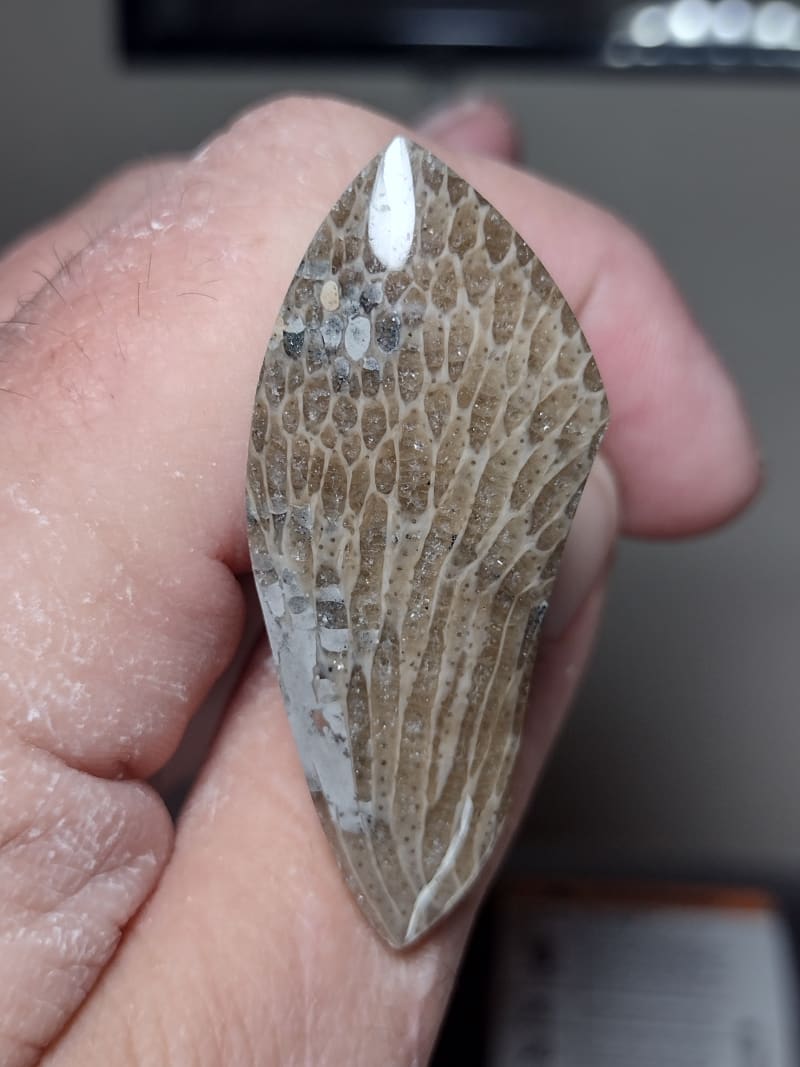 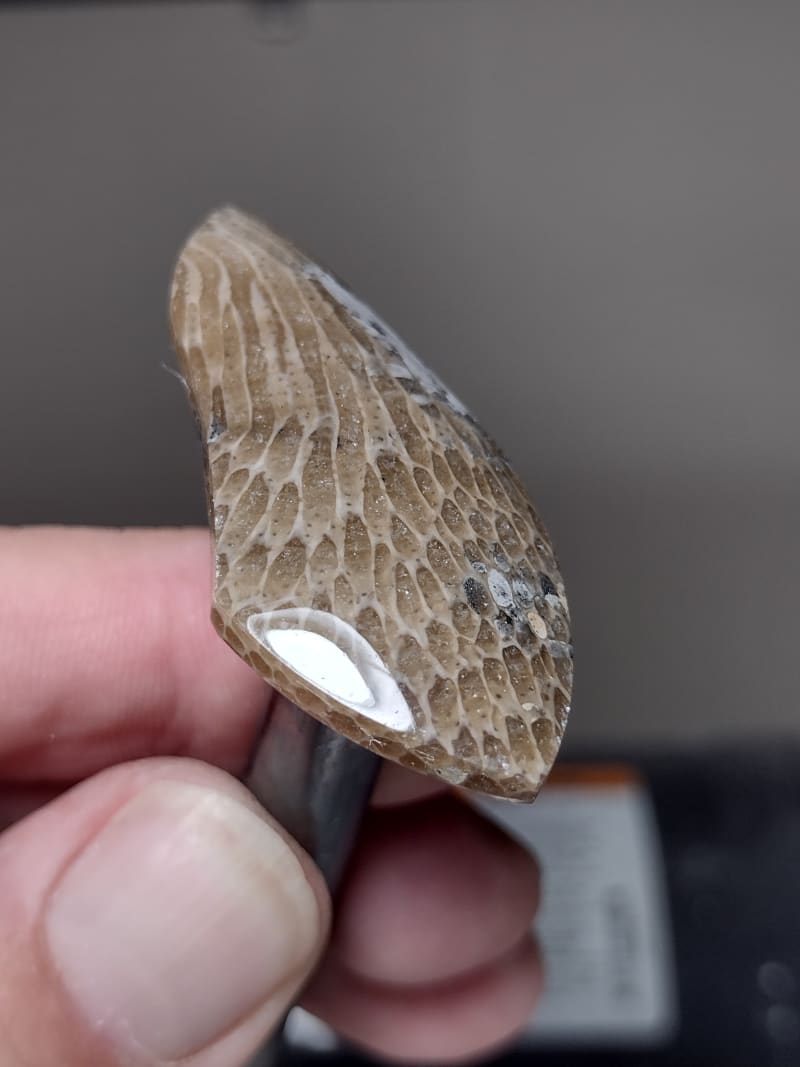 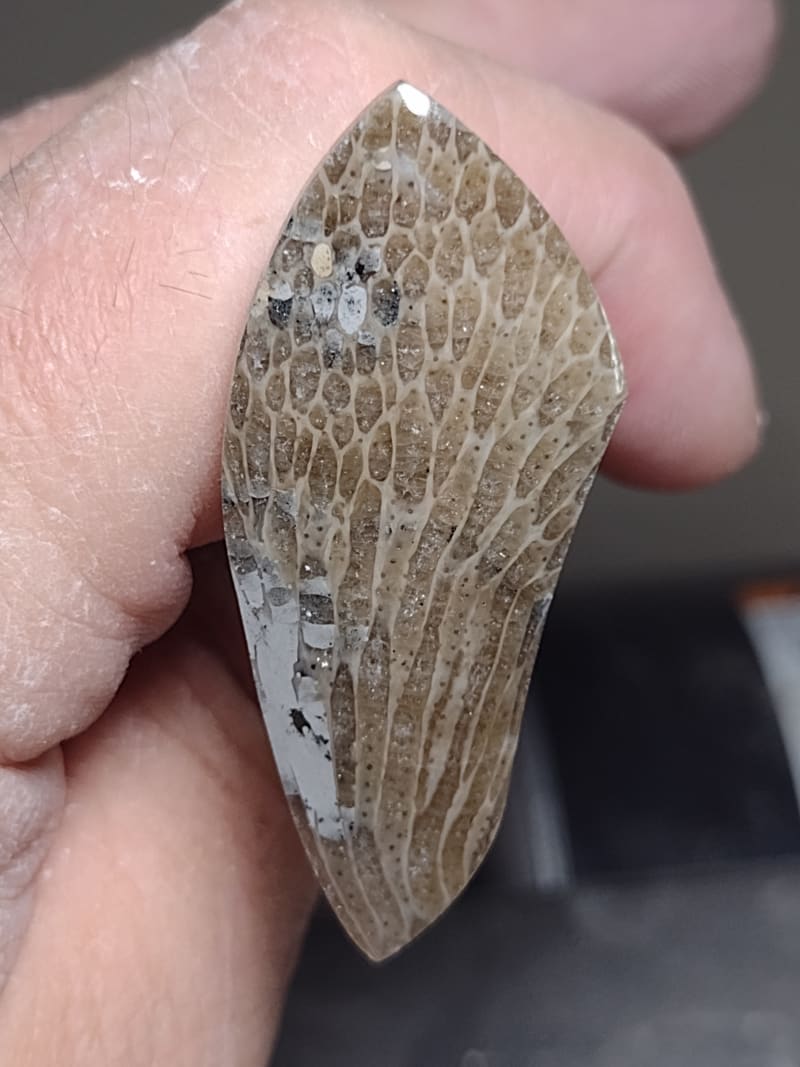 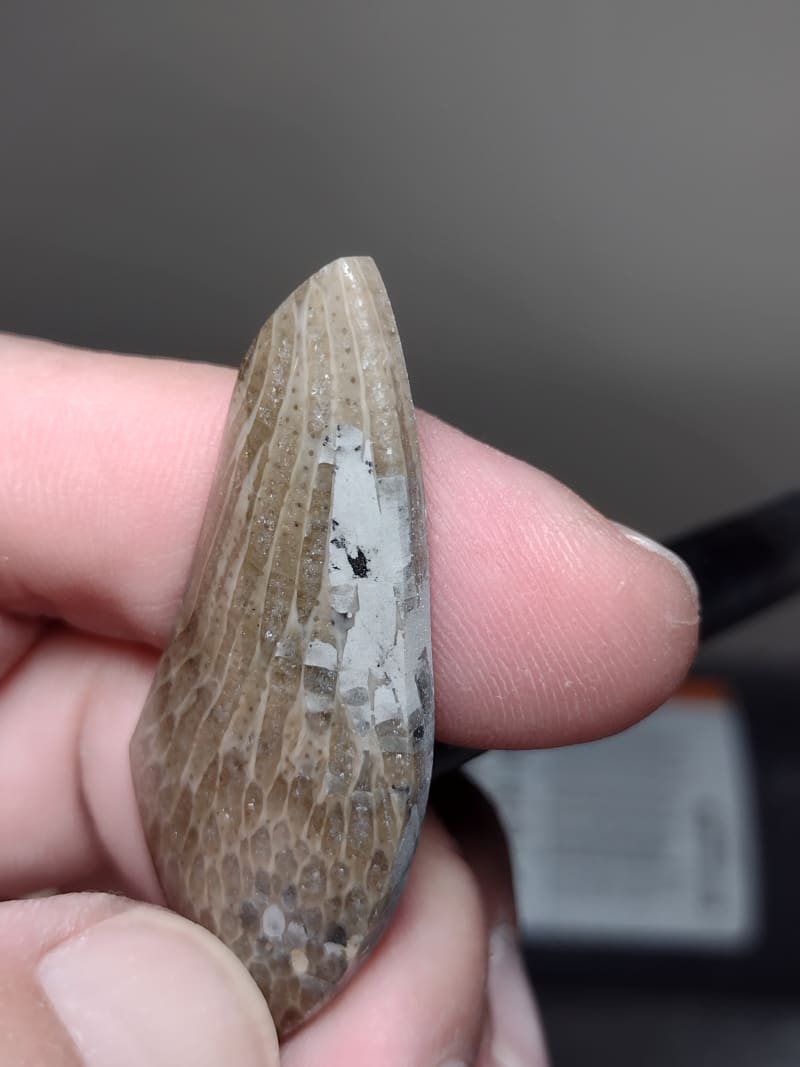 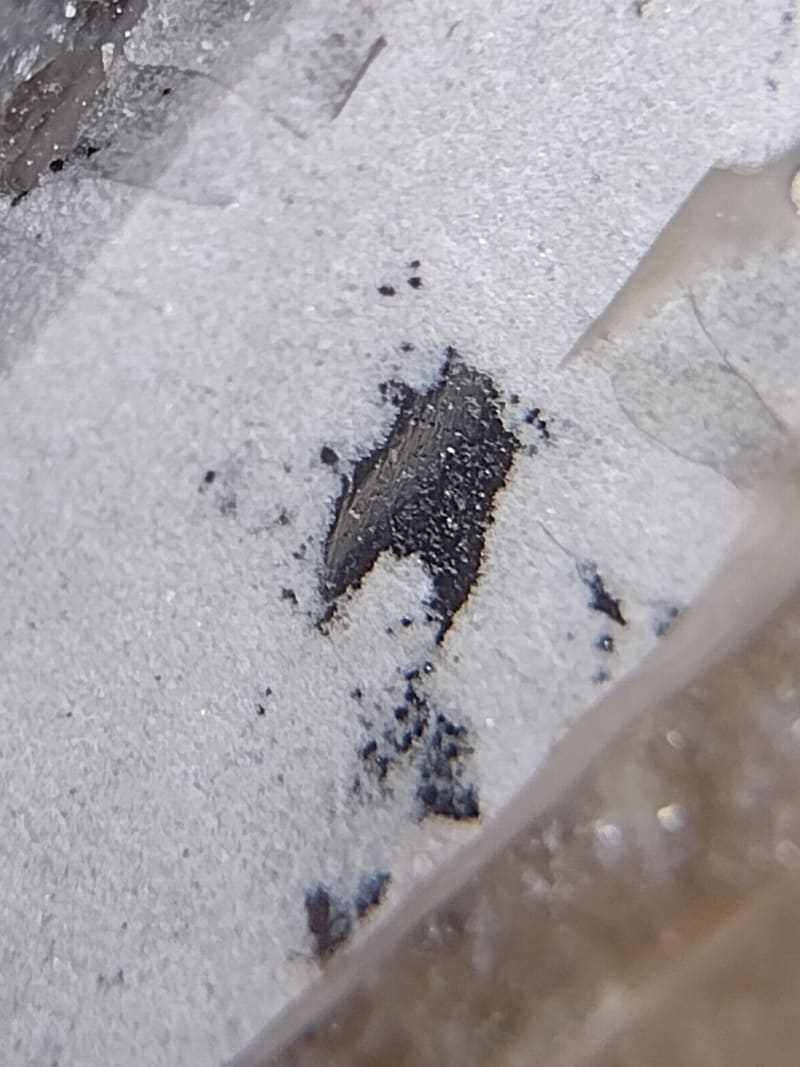 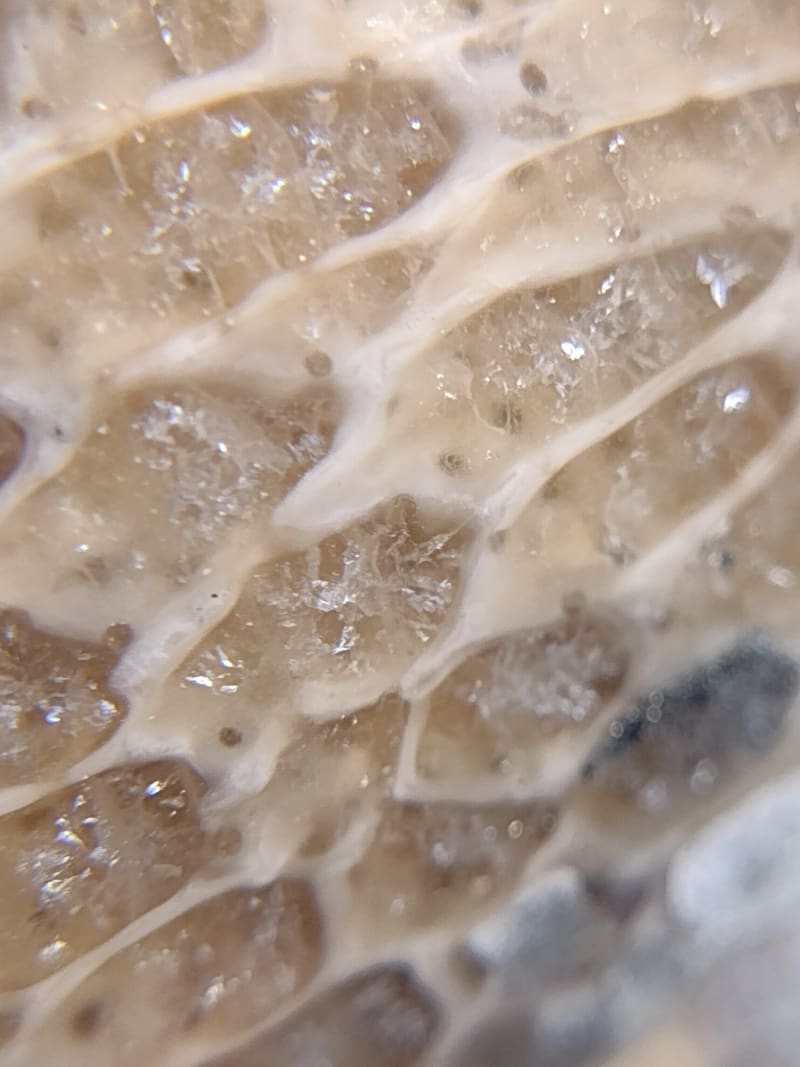
|
|
|
|
Post by chris1956 on May 7, 2024 7:39:17 GMT -5
chris1956 Jugglerguy Here's one cab...the other popped off dop! Arghh!! There's a LOT going on in this stuff!! I tried to take some pics from different angles to show lighting differently. It'll definitely take a polish (as Chris has shown!)...except for the gray areas...which are as soft as regular mud! I took a couple macro shots with the loupe. That black area in the gray spot is metal!! There's more in that upper gray area as well! gemfeller - that macro of the insides of the tubes make it look like it's quartz!       That pattern really fits the shape you made! I hope you can work around the mud areas. I often see very small specs of metal in the Petoskey stones. |
|
|
|
Post by Jugglerguy on May 7, 2024 9:00:21 GMT -5
Looks good, Jason (except for the muddy areas, but that's not your fault).
Is it metal you're seeing, or pyrite? I always thought it was pyrite, but I could be wrong about that.
|
|
|
|
Post by jasoninsd on May 7, 2024 17:36:50 GMT -5
chris1956 Jugglerguy Here's one cab...the other popped off dop! Arghh!! There's a LOT going on in this stuff!! I tried to take some pics from different angles to show lighting differently. It'll definitely take a polish (as Chris has shown!)...except for the gray areas...which are as soft as regular mud! I took a couple macro shots with the loupe. That black area in the gray spot is metal!! There's more in that upper gray area as well! gemfeller - that macro of the insides of the tubes make it look like it's quartz!       That pattern really fits the shape you made! I hope you can work around the mud areas. I often see very small specs of metal in the Petoskey stones. Thanks Chris! I know it was probably already told to me...to be aware of the gray areas...but now I proved it! LOL I do know going forward, to do everything I can to avoid them! Looks good, Jason (except for the muddy areas, but that's not your fault). Is it metal you're seeing, or pyrite? I always thought it was pyrite, but I could be wrong about that. Thanks Rob!  It probably is pyrite...I had no clue what kind of metal it was. It reflected the light like it was a metal...and pyrite definitely makes sense! |
|
|
|
Post by chris1956 on May 7, 2024 17:57:16 GMT -5
I should have included a warning about the mud in the box I sent.  The larger one has the darker curved bands as you go along the rock. I think that these bands will polish (but I could be wrong as that seems to happen a lot). Here is a picture of a much smaller one with the dark bands and I can't see any difference in polihsh on the bands compared to the rest of the stone. This is two sides of the same stone. 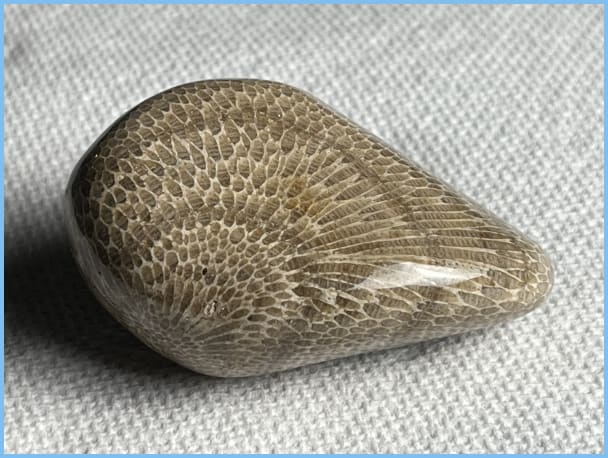 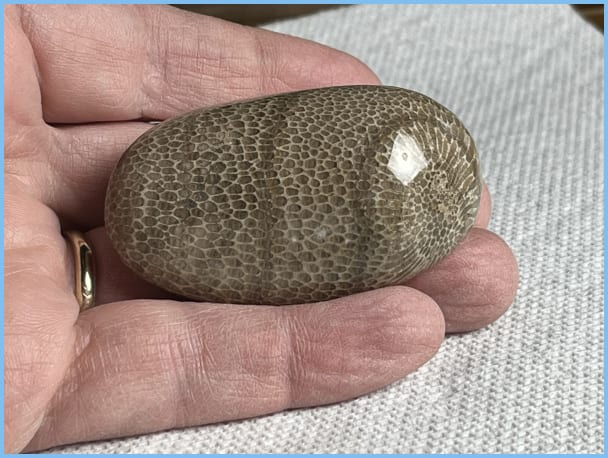 |
|
dillonf
fully equipped rock polisher
   Hounding and tumbling
Hounding and tumbling
Member since February 2022
Posts: 1,622
|
Post by dillonf on May 7, 2024 21:43:18 GMT -5
Very Nice
|
|
|
|
Post by jasoninsd on May 8, 2024 19:02:24 GMT -5
I should have included a warning about the mud in the box I sent.  The larger one has the darker curved bands as you go along the rock. I think that these bands will polish (but I could be wrong as that seems to happen a lot). Here is a picture of a much smaller one with the dark bands and I can't see any difference in polihsh on the bands compared to the rest of the stone. This is two sides of the same stone.   OMG Chris!! If I can get a cab like that polished piece pictured, I'd be happier than a pig in sh!t!! That's gorgeousssss!!    Thanks Dillon!!  |
|
|
|
Post by chris1956 on May 8, 2024 19:20:46 GMT -5
Jason. I just noticed that the cab you finished has tiny "holes" through the light material and what is in the "holes" must be clear and be showing the underlying darker material? Good closeups by the way. Will have to try your loop trick next time I need a closeup. I hadn't noticed that in other Charlevoix stones but I looked at the one I posted above and there is one area that shows the same "holes". I am guessing that these are the "stems" through which the nutrients moved? Stem isn't the right term since they were animals but couldn't find a good diagram that called it out. I am thinking it is similar to the middle holes you see in crinoid rings.
|
|
|
|
Post by chris1956 on May 8, 2024 19:31:48 GMT -5
Here is what I found for crinoids so I am assuming it is something similar for Charlevoix stone. Also found for crinoids they are called stems.
The inside of the crinoid stem contained coelomic and neural tissue (basically these are the vital organs for movement, digestion, respiration, and reproduction).
|
|
|
|
Post by jasoninsd on May 8, 2024 19:33:06 GMT -5
Jason. I just noticed that the cab you finished has tiny "holes" through the light material and what is in the "holes" must be clear and be showing the underlying darker material? Good closeups by the way. Will have to try your loop trick next time I need a closeup. I hadn't noticed that in other Charlevoix stones but I looked at the one I posted above and there is one area that shows the same "holes". I am guessing that these are the "stems" through which the nutrients moved? Stem isn't the right term since they were animals but couldn't find a good diagram that called it out. I am thinking it is similar to the middle holes you see in crinoid rings. I just went searching to see if I could find a "cross section" diagram of a coral...but it didn't seem to coincide... I went and looked again at the piece through the loupe. The "dots" don't seem to be the ends of tubes...so I'm not sure what they are exactly. The "tubes" seem to have a quartz-like fill in them...and I assumed they were the feeding tubes... They're definitely fascinating when you start looking at them through a loupe! |
|
titaniumkid
spending too much on rocks
 
Member since June 2023
Posts: 499
|
Post by titaniumkid on May 8, 2024 19:45:44 GMT -5
The animals in corals are called polyps. I have diagrams of coral polyps but not sure if I have any of hard corals... they seem to like drawing soft corals, these horrible scientists. Let me see what I can find  Beautiful stones, by the way. |
|
|
|
Post by jasoninsd on May 8, 2024 20:00:49 GMT -5
The animals in corals are called polyps. I have diagrams of coral polyps but not sure if I have any of hard corals... they seem to like drawing soft corals, these horrible scientists. Let me see what I can find  Beautiful stones, by the way. Thanks!!  I hear the word "polyps" and I get an uncontrollable cringe! LOL |
|
titaniumkid
spending too much on rocks
 
Member since June 2023
Posts: 499
|
Post by titaniumkid on May 8, 2024 20:15:39 GMT -5
The small holes are possibly mural pores, which were used for transferring nutrients between polyps. It's cool you can see these details on your polished stones. I'm unsure, but possibly the "tissue connection to adjacent polyp" in panel c of the diagram might have involved the mural pore. Just a guess. (diagram credit: Biology of the Invertebrates, Pechenik 2005).  These wikipedia pages have better info because my books don't deal with extinct coral classes. en.wikipedia.org/wiki/Favositesen.wikipedia.org/wiki/Tabulata |
|
titaniumkid
spending too much on rocks
 
Member since June 2023
Posts: 499
|
Post by titaniumkid on May 8, 2024 20:16:25 GMT -5
The animals in corals are called polyps. I have diagrams of coral polyps but not sure if I have any of hard corals... they seem to like drawing soft corals, these horrible scientists. Let me see what I can find  Beautiful stones, by the way. Thanks!!  I hear the word "polyps" and I get an uncontrollable cringe! LOL It's an unfortunate name. |
|
|
|
Post by jasoninsd on May 8, 2024 20:17:39 GMT -5
The small holes are possibly mural pores, which were used for transferring nutrients between polyps. It's cool you can see these details on your polished stones. I'm unsure, but possibly the "tissue connection to adjacent polyp" in panel c of the diagram might have involved the mural pore. Just a guess. (diagram credit: Biology of the Invertebrates, Pechenik 2005).  These wikipedia pages have better info because my books don't deal with extinct coral classes. en.wikipedia.org/wiki/Favositesen.wikipedia.org/wiki/TabulataA very serious thank you for bringing the science into this!!  |
|
titaniumkid
spending too much on rocks
 
Member since June 2023
Posts: 499
|
Post by titaniumkid on May 8, 2024 20:18:50 GMT -5
The small holes are possibly mural pores, which were used for transferring nutrients between polyps. It's cool you can see these details on your polished stones. I'm unsure, but possibly the "tissue connection to adjacent polyp" in panel c of the diagram might have involved the mural pore. Just a guess. (diagram credit: Biology of the Invertebrates, Pechenik 2005).  These wikipedia pages have better info because my books don't deal with extinct coral classes. en.wikipedia.org/wiki/Favositesen.wikipedia.org/wiki/TabulataA very serious thank you for bringing the science into this!!  I apologise for the geekiness. As you can see, I'm procrastinating  |
|
|
|
Post by jasoninsd on May 8, 2024 20:23:47 GMT -5
A very serious thank you for bringing the science into this!!  I apologise for the geekiness. As you can see, I'm procrastinating  I was for real with the "thank you"!  I actually enjoy reading some of the "in-depth" info a lot of members have! I don't have the background...so it's nice when members are willing to take the time to share some tidbits of info I would have never thought to investigate!  |
|
|
|
Post by chris1956 on May 8, 2024 20:39:27 GMT -5
The small holes are possibly mural pores, which were used for transferring nutrients between polyps. It's cool you can see these details on your polished stones. I'm unsure, but possibly the "tissue connection to adjacent polyp" in panel c of the diagram might have involved the mural pore. Just a guess. (diagram credit: Biology of the Invertebrates, Pechenik 2005).  These wikipedia pages have better info because my books don't deal with extinct coral classes. en.wikipedia.org/wiki/Favositesen.wikipedia.org/wiki/TabulataGood info. Thanks for posting that. Didn't realize there were so many types of Favosites but it makes sense. I think you nailed it on the mural pores. I should probably call it Favosites rather than Charlevoix stone. When I was a kid growing up in the town of Petoskey (15 miles from the town of Charlevoix) I don't recall anyone refering to these stones as Charlevoix stones. I think they made that up because they were jealous of the "Petoskey stones".  I hope there isn't someone on here from Charlevoix. I'm sure I will hear about it if there is.  |
|